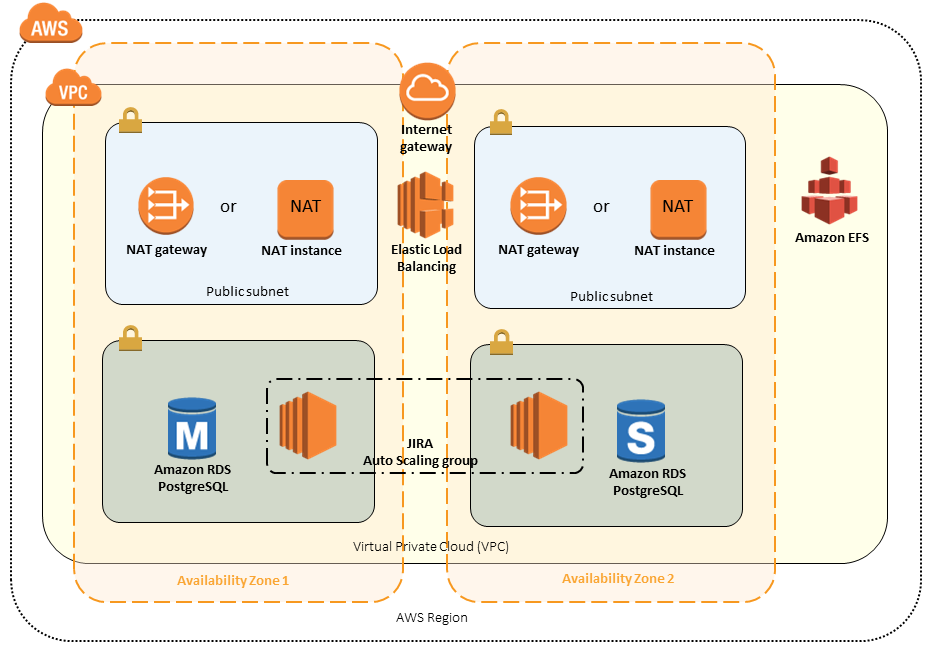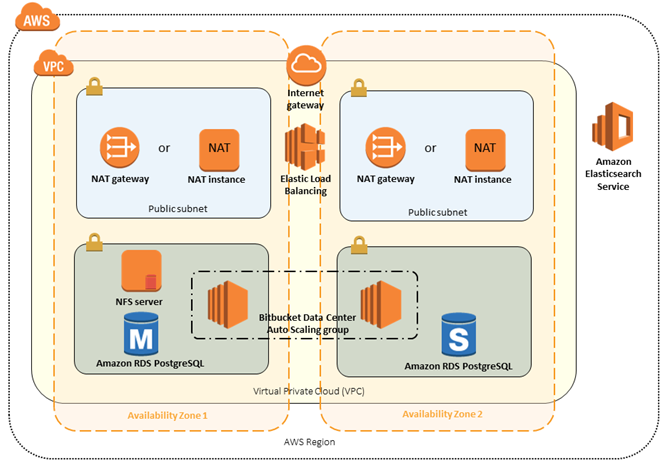Our DevOps can configure any type of environment to suit your needs (10 users to 10,000+ users). In addition, AWS allows you to easily scale your environment as your team grows.
Here are some typical scenarios used by our customers.
Scenario #1

For one customer, we set up JIRA on a t2.small EC2 instance with the data residing on a separate EBS volume and Confluence on a t2.medium EC2 instance with the data residing on a separate EBS volume. Both JIRA and Confluence are using the same PostgreSQL server.
Scenario #2

If you need high-availability and performance at scale in an enterprise environment, perhaps JIRA Software Data Center will suit your needs.
Amazon RDS PostgreSQL – JIRA Data Center requires a supported external database. Amazon RDS for PostgreSQL in a Multi-AZ configuration allows failover in the event the master node fails.
Amazon Elastic File System – JIRA Software Data Center uses a shared file system to store artifacts in a common location that is accessible to multiple JIRA nodes. The Quick Start architecture implements a highly available shared file system using Amazon Elastic File System.
JIRA Auto Scaling Group – The JIRA Data Center product is installed on Amazon Elastic Compute Cloud (EC2) instances in an Auto Scaling group. The deployment will scale out and in, based on utilization.
Scenario #3

If you need an enterprise grade Git repository management solution, you may want to consider Bitbucket Data Center.
Amazon RDS PostgreSQL – Bitbucket Data Center requires a supported external database. Amazon RDS for PostgreSQL in a Multi-AZ configuration allows failover in the event the master node fails.
NFS Server – Bitbucket Data Center uses a shared file system to store the repositories in a common location that is accessible to multiple Bitbucket nodes. The Quick Start architecture implements the shared file system in an EC2 instance with an attached Amazon Elastic Block Store (EBS) volume.
Bitbucket Auto Scaling Group – The Bitbucket Data Center product is installed on Amazon Elastic Compute Cloud (EC2) instances in an Auto Scaling group. The deployment will scale out and in, based on utilization.
Amazon Elasticsearch Service – Bitbucket Data Center uses Elasticsearch for indexing and searching. The Quick Start architecture uses Amazon Elasticsearch Service, a managed service that makes it easy to deploy, operate, and scale Elasticsearch in the AWS Cloud.
NGINX
NGINX is a free, open-source, high-performance HTTP server and reverse proxy, as well as an IMAP/POP3 proxy server. NGINX is known for its high performance, stability, rich feature set, simple configuration, and low resource consumption.
NGINX is one of a handful of servers written to address the C10K problem. Unlike traditional servers, NGINX doesn’t rely on threads to handle requests. Instead it uses a much more scalable event-driven (asynchronous) architecture. This architecture uses small, but more importantly, predictable amounts of memory under load. Even if you don’t expect to handle thousands of simultaneous requests, you can still benefit from NGINX’s high-performance and small memory footprint. NGINX scales in all directions: from the smallest VPS all the way up to large clusters of servers.
NGINX powers several high-visibility sites, such as Netflix, Hulu, Pinterest, CloudFlare, Airbnb, WordPress.com, GitHub, SoundCloud, Zynga, Eventbrite, Zappos, Media Temple, Heroku, RightScale, Engine Yard, MaxCDN and many others.
We recommend using NGINX to proxy requests for JIRA or Confluence running in a standard Tomcat container. Putting JIRA or Confluence behind a NGINX proxy server will give you the option of hiding the port numbers.
Free SSL Certificates using Let’s Encrypt
To enable HTTPS on your website, you need to get a certificate (a type of file) from a Certificate Authority (CA). Let’s Encrypt is a CA. In order to get a certificate for your website’s domain from Let’s Encrypt, you have to demonstrate control over the domain. With Let’s Encrypt, you do this using software that uses the ACME protocol, which typically runs on your web host.
We will configure HTTPS for your Atlassian web server with automatic certificate renewals every 90 days.
